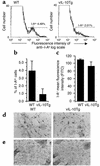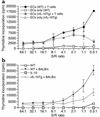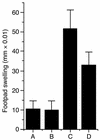Altered cutaneous immune parameters in transgenic mice overexpressing viral IL-10 in the epidermis
- PMID: 12813028
- PMCID: PMC161417
- DOI: 10.1172/JCI15722
Altered cutaneous immune parameters in transgenic mice overexpressing viral IL-10 in the epidermis
Abstract
IL-10 is a pleiotropic cytokine that inhibits several immune parameters, including Th1 cell-mediated immune responses, antigen presentation, and antigen-specific T cell proliferation. Recent data implicate IL-10 as a mediator of suppression of cell-mediated immunity induced by exposure to UVB radiation (280-320 nm). To investigate the effects of IL-10 on the cutaneous immune system, we engineered transgenic mice that overexpress viral IL-10 (vIL-10) in the epidermis. vIL-10 transgenic mice demonstrated a reduced number of I-A(+) epidermal and dermal cells and fewer I-A(+) hapten-bearing cells in regional lymph nodes after hapten painting of the skin. Reduced CD80 and CD86 expression by I-A(+) epidermal cells was also observed. vIL-10 transgenic mice demonstrated a smaller delayed-type hypersensitivity response to allogeneic cells upon challenge but had normal contact hypersensitivity to an epicutaneously applied hapten. Fresh epidermal cells from vIL-10 transgenic mice showed a decreased ability to stimulate allogeneic T cell proliferation, as did splenocytes. Additionally, chronic exposure of mice to UVB radiation led to the development of fewer skin tumors in vIL-10 mice than in WT controls, and vIL-10 transgenic mice had increased splenic NK cell activity against YAC-1targets. These findings support the concept that IL-10 is an important regulator of cutaneous immune function.
Figures








References
-
- Taga K, Tosato G. IL-10 inhibits human T cell proliferation and IL-2 production. J. Immunol. 1992;148:1143–1148. - PubMed
-
- Del Prete G, et al. Human IL-10 is produced by both type 1 helper (Th1) and type 2 helper (Th2) T cell clones and inhibits their antigen-specific proliferation and cytokine production. J. Immunol. 1993;150:353–360. - PubMed
-
- Li L, Elliott JF, Mosmann TR. IL-10 inhibits cytokine production, vascular leakage, and swelling during T helper 1 cell-induced delayed-type hypersensitivity. J. Immunol. 1994;153:3967–3978. - PubMed
-
- Macatonia SE, Doherty TM, Knight SC, O’Garra A. Differential effect of IL-10 on dendritic cell-induced T cell proliferation and IFN-gamma production. J. Immunol. 1993;150:3755–3765. - PubMed
-
- Enk AH, Angeloni VL, Udey MC, Katz SI. Inhibition of Langerhans cell antigen-presenting function by IL-10. A role for IL-10 in induction of tolerance. J. Immunol. 1993;151:2390–2398. - PubMed
Publication types
MeSH terms
Substances
Grants and funding
LinkOut - more resources
Full Text Sources
Molecular Biology Databases

